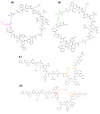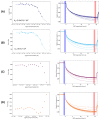Structure-Activity Relationship Investigations of Novel Constrained Chimeric Peptidomimetics of SOCS3 Protein Targeting JAK2
- PMID: 35455455
- PMCID: PMC9031227
- DOI: 10.3390/ph15040458
Structure-Activity Relationship Investigations of Novel Constrained Chimeric Peptidomimetics of SOCS3 Protein Targeting JAK2
Abstract
SOCS3 (suppressor of cytokine signaling 3) protein suppresses cytokine-induced inflammation and its deletion in neurons or immune cells increases the pathological growth of blood vessels. Recently, we designed several SOCS3 peptidomimetics by assuming as template structures the interfacing regions of the ternary complex constituted by SOCS3, JAK2 (Janus Kinase 2) and gp130 (glycoprotein 130) proteins. A chimeric peptide named KIRCONG chim, including non-contiguous regions demonstrated able to bind to JAK2 and anti-inflammatory and antioxidant properties in VSMCs (vascular smooth muscle cells). With the aim to improve drug-like features of KIRCONG, herein we reported novel cyclic analogues bearing different linkages. In detail, in two of them hydrocarbon cycles of different lengths were inserted at positions i/i+5 and i/i+7 to improve helical conformations of mimetics. Structural features of cyclic compounds were investigated by CD (Circular Dichroism) and NMR (Nuclear Magnetic Resonance) spectroscopies while their ability to bind to catalytic domain of JAK2 was assessed through MST (MicroScale Thermophoresis) assay as well as their stability in biological serum. Overall data indicate a crucial role exerted by the length and the position of the cycle within the chimeric structure and could pave the way to the miniaturization of SOCS3 protein for therapeutic aims.
Keywords: JAK/STAT; SOCS3; cytokine signaling; mimetic peptides; stapled peptides.
Conflict of interest statement
The authors declare no conflict of interest.
Figures





Similar articles
-
PEGylated SOCS3 Mimetics Encapsulated into PLGA-NPs as Selective Inhibitors of JAK/STAT Pathway in TNBC Cells.Int J Nanomedicine. 2024 Jul 18;19:7237-7251. doi: 10.2147/IJN.S441205. eCollection 2024. Int J Nanomedicine. 2024. PMID: 39050870 Free PMC article.
-
Chimeric Peptidomimetics of SOCS 3 Able to Interact with JAK2 as Anti-inflammatory Compounds.ACS Med Chem Lett. 2020 Mar 19;11(5):615-623. doi: 10.1021/acsmedchemlett.9b00664. eCollection 2020 May 14. ACS Med Chem Lett. 2020. PMID: 32435361 Free PMC article.
-
Design and functional studies of xylene-based cyclic mimetics of SOCS1 protein.Eur J Med Chem. 2025 Jan 15;282:117107. doi: 10.1016/j.ejmech.2024.117107. Epub 2024 Nov 25. Eur J Med Chem. 2025. PMID: 39608205
-
The biology and mechanism of action of suppressor of cytokine signaling 3.Growth Factors. 2012 Aug;30(4):207-19. doi: 10.3109/08977194.2012.687375. Epub 2012 May 11. Growth Factors. 2012. PMID: 22574771 Free PMC article. Review.
-
Inhibition of IL-6 family cytokines by SOCS3.Semin Immunol. 2014 Feb;26(1):13-9. doi: 10.1016/j.smim.2013.12.004. Epub 2014 Jan 10. Semin Immunol. 2014. PMID: 24418198 Free PMC article. Review.
Cited by
-
PEGylated SOCS3 Mimetics Encapsulated into PLGA-NPs as Selective Inhibitors of JAK/STAT Pathway in TNBC Cells.Int J Nanomedicine. 2024 Jul 18;19:7237-7251. doi: 10.2147/IJN.S441205. eCollection 2024. Int J Nanomedicine. 2024. PMID: 39050870 Free PMC article.
-
SOCS1 and SOCS3 as key checkpoint molecules in the immune responses associated to skin inflammation and malignant transformation.Front Immunol. 2024 Jun 21;15:1393799. doi: 10.3389/fimmu.2024.1393799. eCollection 2024. Front Immunol. 2024. PMID: 38975347 Free PMC article. Review.
-
Are peptidomimetics the compounds of choice for developing new modulators of the JAK-STAT pathway?Front Immunol. 2024 Jun 24;15:1406886. doi: 10.3389/fimmu.2024.1406886. eCollection 2024. Front Immunol. 2024. PMID: 38983855 Free PMC article. Review.
-
Discovery and biological evaluation of a novel and highly potent JAK2 inhibitor for the treatment of triple negative breast cancer.J Enzyme Inhib Med Chem. 2025 Dec;40(1):2488127. doi: 10.1080/14756366.2025.2488127. Epub 2025 Apr 29. J Enzyme Inhib Med Chem. 2025. PMID: 40298145 Free PMC article.
-
SOCS3 regulates pathological retinal angiogenesis through modulating SPP1 expression in microglia and macrophages.Mol Ther. 2024 May 1;32(5):1425-1444. doi: 10.1016/j.ymthe.2024.03.025. Epub 2024 Mar 19. Mol Ther. 2024. PMID: 38504518 Free PMC article.
References
Grants and funding
LinkOut - more resources
Full Text Sources
Miscellaneous

